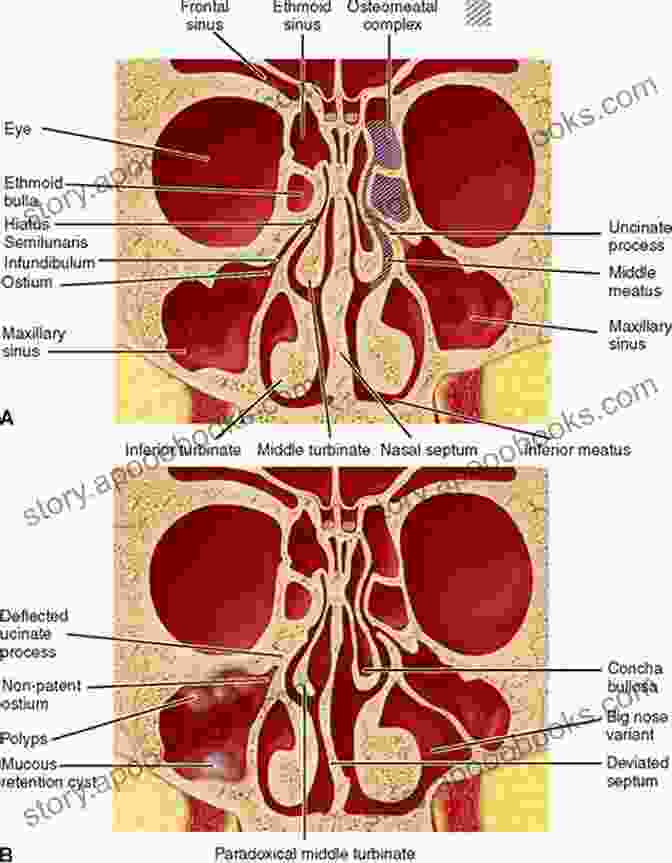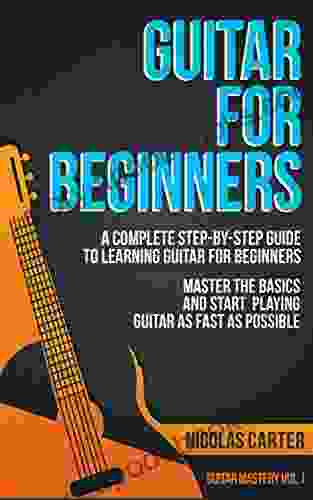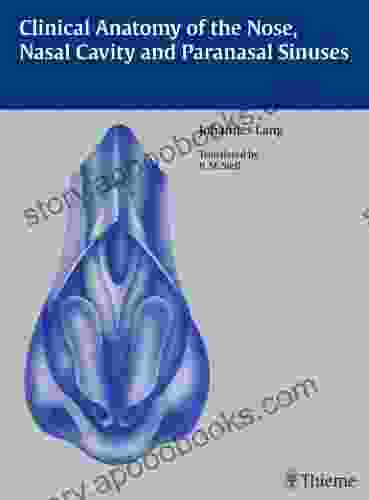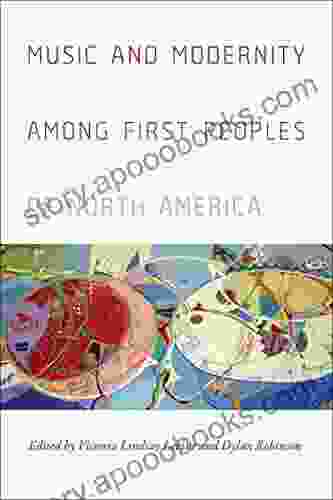Clinical Anatomy of the Nose, Nasal Cavity, and Paranasal Sinuses: A Comprehensive Guide


The nose, nasal cavity, and paranasal sinuses are interconnected structures that play crucial roles in respiration, olfaction, and voice production. Understanding their complex anatomy is essential for medical professionals, particularly in the fields of otorhinolaryngology and maxillofacial surgery. This article delves into the clinical anatomy of these structures, providing a comprehensive overview of their components, topographic relationships, and clinical significance.
I. The Nose
The nose is the external, visible portion of the respiratory system. It состоит of two nostrils, separated by the nasal septum, and is supported by a framework of bones and cartilage. The external nose can be divided into three regions:
5 out of 5
| Language | : | English |
| File size | : | 56332 KB |
| Text-to-Speech | : | Enabled |
| Screen Reader | : | Supported |
| Enhanced typesetting | : | Enabled |
| Print length | : | 152 pages |
A. Bony Framework
* Nasal bones: Two small bones that form the bridge of the nose. * Maxillae: Large bones that form the cheeks and the floor of the nasal cavity. * Frontal bone: Forms the roof of the nasal cavity.
B. Cartilaginous Framework
* Nasal septum: A midline cartilage that divides the nasal cavity into two halves. * Upper lateral cartilages: Located on either side of the nasal septum, forming the roof and lateral walls of the nasal cavity. * Lower lateral cartilages: Located below the upper lateral cartilages, forming the alae (wings) of the nose.
C. Soft Tissues
The external nose is covered by skin and subcutaneous tissue. The inner lining of the nose is a mucous membrane called the nasal mucosa. The nasal mucosa is composed of respiratory epithelium and contains numerous blood vessels and glands that produce mucus.
II. The Nasal Cavity
The nasal cavity is a hollow space within the skull that lies posterior to the nose. It is divided into two halves by the nasal septum. The nasal cavity can be divided into three regions:
A. Vestibule
* The most anterior region of the nasal cavity. * Lined by skin and contains hair follicles and sebaceous glands. * Serves to filter and warm incoming air.
B. Respiratory Region
* The middle and largest region of the nasal cavity. * Lined by ciliated pseudostratified columnar epithelium with goblet cells. * Contains the olfactory mucosa, responsible for olfaction. * Turbinates (conchae): Thin, scroll-like bones projecting from the lateral walls of the nasal cavity. They increase the surface area for mucus production and air turbulence.
C. Olfactory Region
* The posterior region of the nasal cavity. * Lined by specialized olfactory epithelium containing olfactory sensory neurons. * Responsible for detecting and transmitting olfactory stimuli to the brain.
III. The Paranasal Sinuses
The paranasal sinuses are air-filled cavities located within the bones of the skull. They are connected to the nasal cavity and lined by the same type of mucous membrane. The paranasal sinuses have several functions, including:
* Reducing the weight of the skull. * Resonating the voice. * Humidifying and warming incoming air. * Protecting the brain and eyes from trauma.
There are four pairs of paranasal sinuses:
A. Maxillary Sinuses
* The largest paranasal sinuses, located within the maxillae. * Drain into the middle meatus of the nasal cavity.
B. Frontal Sinuses
* Located within the frontal bone. * Drain into the ethmoid infundibulum.
C. Ethmoid Sinuses
* The most anterior paranasal sinuses, located within the ethmoid bone. * Divided into anterior, middle, and posterior groups. * Drain into the middle meatus of the nasal cavity.
D. Sphenoid Sinuses
* The most posterior paranasal sinuses, located within the sphenoid bone. * Drain into the sphenoethmoidal recess.
IV. Clinical Significance
Understanding the clinical anatomy of the nose, nasal cavity, and paranasal sinuses is essential for the diagnosis and management of a wide range of conditions. Some common clinical applications include:
A. Nasal Surgery
* Rhinoplasty: Surgery to reshape the nose for aesthetic or functional purposes. * Septoplasty: Surgery to correct a deviated nasal septum. * Turbinectomy: Surgery to remove or reduce enlarged turbinates.
B. Sinus Surgery
* Functional endoscopic sinus surgery (FESS): A minimally invasive procedure to remove blockages and improve drainage of the paranasal sinuses. * Caldwell-Luc procedure: A traditional surgical approach to the maxillary sinus.
C. Olfactory DisFree Downloads
* Anosmia: Loss of smell. * Parosmia: Distortion of smell. * Hyposmia: Decreased sense of smell.
D. Nasal Trauma
* Epistaxis: Nosebleeds. * Nasal fractures. * Soft tissue injuries.
The nose, nasal cavity, and paranasal sinuses are complex and interconnected structures that play crucial roles in various physiological functions. Understanding their detailed clinical anatomy is essential for medical professionals involved in the diagnosis and management of otorhinolaryngological and maxillofacial conditions. This knowledge enables accurate diagnosis, effective surgical interventions, and appropriate management of nasal and sinus disFree Downloads.
5 out of 5
| Language | : | English |
| File size | : | 56332 KB |
| Text-to-Speech | : | Enabled |
| Screen Reader | : | Supported |
| Enhanced typesetting | : | Enabled |
| Print length | : | 152 pages |
Do you want to contribute by writing guest posts on this blog?
Please contact us and send us a resume of previous articles that you have written.
 Book
Book Novel
Novel Page
Page Chapter
Chapter Text
Text Story
Story Genre
Genre Reader
Reader Library
Library Paperback
Paperback E-book
E-book Magazine
Magazine Newspaper
Newspaper Paragraph
Paragraph Sentence
Sentence Bookmark
Bookmark Shelf
Shelf Glossary
Glossary Bibliography
Bibliography Foreword
Foreword Preface
Preface Synopsis
Synopsis Annotation
Annotation Footnote
Footnote Manuscript
Manuscript Scroll
Scroll Codex
Codex Tome
Tome Bestseller
Bestseller Classics
Classics Library card
Library card Narrative
Narrative Biography
Biography Autobiography
Autobiography Memoir
Memoir Reference
Reference Encyclopedia
Encyclopedia Miles Chapin
Miles Chapin Randi Stone
Randi Stone Karina Wilde
Karina Wilde Mary Mapes
Mary Mapes Raeanna Goss
Raeanna Goss Mary Beth Temple
Mary Beth Temple Thomas Bunstead
Thomas Bunstead Liza Charlesworth
Liza Charlesworth Thomas Perry
Thomas Perry Nelson Lichtenstein
Nelson Lichtenstein Tom Mcbride
Tom Mcbride Marcos Pizarro
Marcos Pizarro Saba Munir Ahmed
Saba Munir Ahmed Nicole Dweck
Nicole Dweck Molly Black
Molly Black Mary Gribbin
Mary Gribbin Omar Prakash
Omar Prakash Sally Robinson
Sally Robinson Ondrej Sarek
Ondrej Sarek Mohammed El Kurd
Mohammed El Kurd
Light bulbAdvertise smarter! Our strategic ad space ensures maximum exposure. Reserve your spot today!

 Abe MitchellUnveiling the Secrets to Thriving in the Face of Adversity: A Comprehensive...
Abe MitchellUnveiling the Secrets to Thriving in the Face of Adversity: A Comprehensive... Charles DickensFollow ·5.7k
Charles DickensFollow ·5.7k Gabriel HayesFollow ·14.5k
Gabriel HayesFollow ·14.5k Wayne CarterFollow ·4k
Wayne CarterFollow ·4k Everett BellFollow ·7.2k
Everett BellFollow ·7.2k Steven HayesFollow ·19k
Steven HayesFollow ·19k Jay SimmonsFollow ·17.4k
Jay SimmonsFollow ·17.4k Clark BellFollow ·18k
Clark BellFollow ·18k José SaramagoFollow ·17.5k
José SaramagoFollow ·17.5k

 Jorge Luis Borges
Jorge Luis BorgesUnlock Your Inner Musician: The Ultimate Guide to...
Embark on a Musical...

 Carlos Drummond
Carlos DrummondQuick Reference Guide To Percussion Instruments And How...
Unleash your inner rhythm with...

 Roberto Bolaño
Roberto BolañoUnlock Your Guitar Potential: The Ultimate Guitar Mastery...
Are you ready...

 Fred Foster
Fred FosterLooking for Lady Dee: A Punk Rock Mystery
By [Author's Name] Looking for Lady Dee is...

 Jacques Bell
Jacques BellJourney into the Mystical Realm of "Heaven Polly Alice...
In the tapestry of literature, where...

 Julio Ramón Ribeyro
Julio Ramón RibeyroSixty Years of Hits: A Musical Journey Through Time
Music has the...
5 out of 5
| Language | : | English |
| File size | : | 56332 KB |
| Text-to-Speech | : | Enabled |
| Screen Reader | : | Supported |
| Enhanced typesetting | : | Enabled |
| Print length | : | 152 pages |










